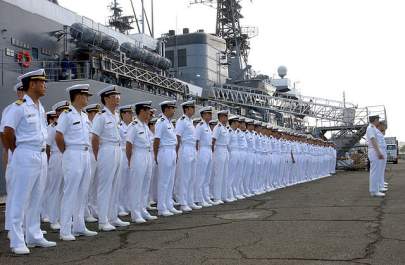Japan Arming for Cold War II

Part one of this series on Japan’s reemergence as a power-projecting nation discussed the causes of Japan’s military modernization and buildup. In this issue, we will explore how and where Japan is using its new military investments.
New Capabilities and Policies
After decades of investing around 1 percent of GDP in defense, Japan has unveiled plans to nearly double defense spending to 2 percent of GDP over the next five years. This will amount to $287 billion in extra defense spending over the next five years—and position Japan as the third-largest defense spender in the world, behind the U.S. and People’s Republic of China (PRC).
This is more of an evolution than a revolution for Tokyo. Spurred by Beijing’s massive military buildup, Japan has increased defense spending annually for more than a decade running. And Japan has been investing those extra resources in a range of high-tech weapons systems, new capabilities and muscular policies.
For example, Japan is upconverting its helicopter carriers into full-fledged aircraft carriers armed with F-35Bs, working closely with the U.S. on regional missile defense, conducting freedom of navigation operations, partnering with Britain and Italy on production of a sixth-generation fighter-bomber, entering into Reciprocal Access Agreements (RAA) with Britain and Australia that enable each nation to deploy military assets on the other’s territory, and providing arms and training to Indonesia, the Philippines and Vietnam.
Japan is standing up air-defense and missile-defense units on Yonaguni Island (just 70 miles east of Taiwan). Japan is rapidly strengthening and expanding its maritime air capabilities by basing F-35Bs on Kyushu, the southernmost of Japan’s four main islands. Japan is building toward a total fleet of 157 F-35 variants, including 42 F-35Bs. Importantly, the F-35B is designed for short take off and vertical landing, which will enable Japan to deploy the high-tech U.S.-designed fighter-bomber from austere island bases or small-deck carriers.
Japan’s navy—officially called the Japanese Maritime Self-Defense Force (JMSDF)—just unveiled its newest submarine: the Taigei. The 3,000-ton warship came into service in 2022, joining 21 other submarines in the JMSDF sub fleet. As the Japan Times reports, the Taigei’s completion means Tokyo has met its 2010 goal of deploying 22 submarines in response to “increasing activities by Beijing in waters near Japan.”
Japan’s military is leading and joining large-scale deterrent maneuvers all across the Indo-Pacific, including air-sea exercises with the U.S, British, Australian and Indian navies, maritime exercises with the U.S. and Indonesia, and joint air training with India in Japan’s skies.
Tokyo is strongly committed to the defense of Taiwan’s democracy and sovereignty, vowing to “closely cooperate” with the Pentagon in the event of a PRC attack on Taiwan. “If a major problem took place in Taiwan, it would not be too much to say that it could relate to a survival-threatening situation,” Japan's deputy prime minister said recently. “We need to think hard that Okinawa could be the next. We are closely monitoring the situation.” A “survival-threatening situation” for Japan, as Reuters explains, “refers to a situation where an armed attack against a foreign country that is in a close relationship with Japan occurs, which in turn poses a clear risk of threatening Japan's survival.” Such a situation would force Japan “to exercise its right of collective self-defense” and come “to the aid of an ally under attack.” A PRC attack on Taiwan would surely involve Japan’s chief treaty ally, the United States. And given a leaked memo penned by Gen. Michael A. Minihan (commander of Air Mobility Command) warning his staff that “My gut tells me we will fight in 2025” over Taiwan, Japan, and America need to be ready.
Underscoring the global nature of the threat posed by tyrant regimes in Beijing and Moscow, Japan participated in the landmark 2022 NATO summit, along with fellow Indo-Pacific democracies Australia, South Korea, and New Zealand. And Japan has shipped drones, battle gear, and humanitarian aid to Ukraine.
Doubtless, the most dramatic evidence of Tokyo’s newfound commitment to military deterrence is Prime Minister Fumio Kishida’s decision to acquire and deploy some 500 Tomahawk cruise missiles from the United States. As The Washington Post reports, the decision marks “a stunning break with a long tradition of eschewing offensive weapons” in postwar Japan. Kishida’s cabinet has concluded that the Tomahawks are needed to “enhance Japan’s conventional deterrent,” as the Post explains. The paper points out that “The Tomahawk missiles, with a 1,000-mile-plus range, would put military targets on mainland China within reach.”
“The introduction of this system will symbolize a major positive change regarding counterstrike capabilities,” an unnamed Japanese official told the Post.
“A key to deterring invasion against Japan is counterstrike capabilities that leverage stand-off defense capability,” Japan’s new National Security Strategy explains. “In cases where an armed attack against Japan has occurred, and as part of that attack ballistic missiles and other means have been used, counterstrike capabilities enable Japan to mount effective counterstrikes against the opponent’s territory…By possessing such capabilities to mount effective counterstrikes, Japan will deter armed attack itself.”
A Stronger Alliance
In all of this, Japan “will work in coordination with the United States to strengthen the Japan-U.S. alliance in all areas, including diplomacy, defense, and economy,” as Japan’s strategy document concludes.
Washington is applauding Tokyo’s growing commitment to the common defense. “The United States is not just taking unilateral steps, but is seeking to empower allies and partners in ways that are deeply significant and magnify our capacities in the region,” a U.S. official told the Post as Tokyo’s Tomahawk plans leaked in December. And in January, the U.S. extended its security guarantee to Japan’s space-based assets—yet another strong deterrent signal to Beijing.
Tokyo’s evolution into a military power is good for the Free World, the Indo-Pacific, and the United States. Just as the island democracy of Britain was America’s bridgehead to the main theater of Cold War I, the island democracy of Japan promises to be America’s bridgehead to the main theater of Cold War II.











